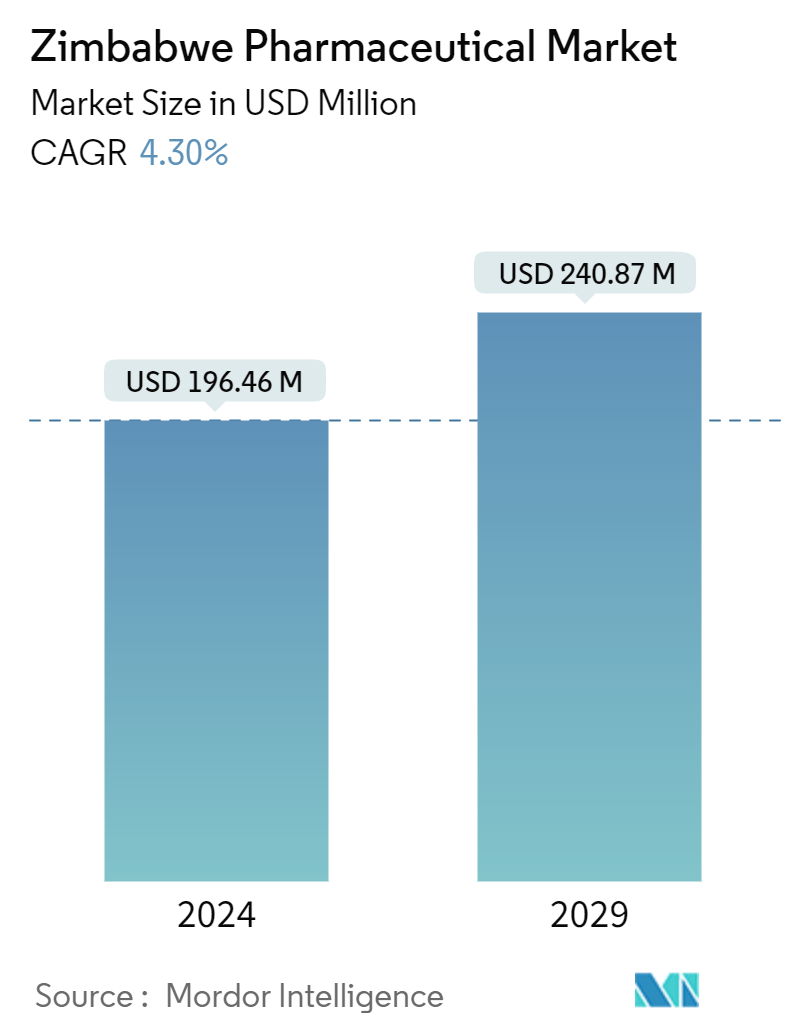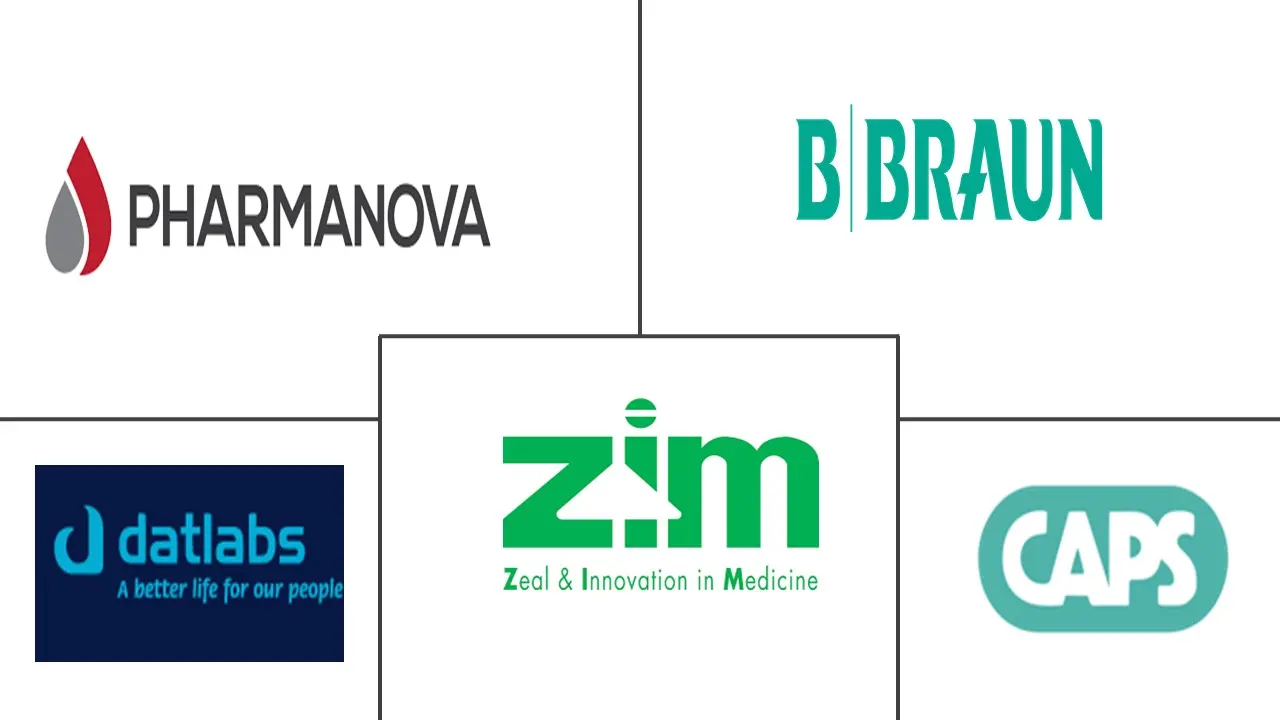Market Size of Zimbabwe Pharmaceutical Industry

| Study Period | 2019 - 2029 |
| Base Year For Estimation | 2023 |
| Forecast Data Period | 2024 - 2029 |
| Market Size (2024) | USD 196.46 Million |
| Market Size (2029) | USD 240.87 Million |
| CAGR (2024 - 2029) | 4.30 % |
Major Players
*Disclaimer: Major Players sorted in no particular order |
Zimbabwe Pharmaceutical Market Analysis
The Zimbabwe Pharmaceutical Market size is estimated at USD 196.46 million in 2024, and is expected to reach USD 240.87 million by 2029, growing at a CAGR of 4.30% during the forecast period (2024-2029).
The COVID-19 impact on the pharmaceutical industry in Zimbabwe was significant. The industry saw an increased demand for therapeutics to treat COVID-19-infected patients, which further led to an increase in the large-scale manufacturing of pharmaceutical products in the country. As the supply chain between the other regions of the world and Zimbabwe was disrupted due to lockdown measures, the local manufacturers played a critical role during the COVID-19 pandemic. For instance, according to a research article published in the Journal of Public Health International in May 2021, the disruption of medical supplies such as pharmaceuticals during the pandemic provided a great opportunity for Zimbabwe to be less dependent on foreign medical supplies, thereby increasing the local manufacturing of therapeutics. However, post-pandemic, the sector has been recovering well since supply chain restrictions were lifted. An increase in the supply of medication from global manufacturers and a rise in initiatives from the key market players, among others, have been leading the market recovery. Moreover, the Zimbabwean Ministry of Health and Child Care (MOHCC) took measures to strengthen the country's ability to produce medical supplies through various organizations such as Varichem, CAPS, Natpharma, and Avail Pharmaceuticals during the pandemic and is expected to impact the market's growth in post-pandemic phase. Thus, as per the analysis, the abovementioned factors significantly affected the market's growth.
With an ageing population and rising rates of chronic disease, Zimbabwe's pharmaceutical sector is poised for expansion. According to the United Nations Population Fund report for 2022, the population aged 65 years and older in Zimbabwe was estimated at 3 million in 2022. The senior population is more likely to suffer from chronic conditions like cardiovascular disease, cancer, and gastrointestinal disorders, hence this demographic shift is predicted to boost the need for drugs in Zimbabwe.
Furthermore, in June 2021, the Zimbabwean government launched the 2021-2025 Pharmaceutical Manufacturing Strategy to improve the local production of drugs, thereby increasing the availability of the country's essential medicines and exporting excess drugs. In addition, in March 2021, the Republic of Zimbabwe became the 19th African Union (AU) Member State to sign the Treaty to establish the African Medicines Agency (AMA). This move may enable a favorable regulatory environment for pharmaceutical research and development, local production, and trade across countries on the African continent. Likewise, in April 2022, the University at Buffalo and the University of Zimbabwe entered a partnership to train future HIV researchers in Zimbabwe and received a USD 1.4 million grant from the National Institutes of Health (NIH). Such initiatives are expected to drive market growth over the forecast period.
Therefore, the demand for effective and novel therapeutics is expected to grow in the coming years. Thus, the abovementioned factors are anticipated to aid the market's growth over the forecast period. However, the stringent regulatory framework is expected to restrain the growth.
Zimbabwe Pharmaceutical Industry Segmentation
As per the scope of the report, pharmaceuticals are referred to as prescription and non-prescription drugs. These medicines can be bought by an individual with or without the doctor's prescription and are safe for consumption for various illnesses with or without the doctor's consent. The Zimbabwe Pharmaceutical Market is Segmented by ATC/Therapeutic Category (Blood and Hematopoietic Organs, Digestive Organ and Metabolism, Cardiovascular System, Nervous System, Musculoskeletal Organ, General Anti-infectives Systemic, Respiratory System, and Other ATC/Therapeutic Categories) and Drug Type (Prescription Type (Branded and Generic), and, OTC Drugs). The report offers the value (USD million) for the above segments.
| By ATC/Therapeutic Category | |
| Blood and Hematopoietic Organs | |
| Digestive Organ and Metabolism | |
| Cardiovascular System | |
| Nervous System | |
| Musculoskeletal Organ | |
| General Antiinfectives Systemic | |
| Respiratory System | |
| Other ATC/Therapeutic Categories |
| By Drug Type | ||||
| ||||
| OTC Drugs |
Zimbabwe Pharmaceutical Market Size Summary
The pharmaceutical industry in Zimbabwe is experiencing a period of growth, driven by several key factors. The COVID-19 pandemic significantly impacted the sector, leading to increased local manufacturing of pharmaceuticals due to disrupted global supply chains. This shift reduced dependency on foreign medical supplies and bolstered the capabilities of local manufacturers. Post-pandemic, the market has been recovering as supply chain restrictions eased, with increased medication supply from global manufacturers and initiatives by key market players. The Zimbabwean government's efforts to enhance local production through organizations like Varichem, CAPS, Natpharma, and Avail Pharmaceuticals are expected to continue supporting market growth. Additionally, the ageing population and rising chronic disease rates are anticipated to further drive demand for pharmaceuticals, particularly in the generic drugs segment, which dominates the market.
The Zimbabwean government's strategic initiatives, such as the 2021-2025 Pharmaceutical Manufacturing Strategy and the country's commitment to the African Medicines Agency, are set to create a favorable environment for pharmaceutical research, development, and trade. These efforts, coupled with partnerships like the one between the University at Buffalo and the University of Zimbabwe, aim to boost local drug production and enhance the availability of essential medicines. The rising prevalence of infectious diseases, such as HIV and TB, along with the increasing approvals of anti-infective drugs, are also contributing to market expansion. The competitive landscape is marked by major players like DatLabs, Pharmanova, and Zim Laboratories, who are actively engaging in acquisitions and joint ventures to strengthen their market positions. Overall, these factors are expected to drive the growth of Zimbabwe's pharmaceutical market over the forecast period.
Zimbabwe Pharmaceutical Market Size - Table of Contents
-
1. MARKET DYNAMICS
-
1.1 Market Overview
-
1.1.1 Healthcare Expenditure (Govt. vs Private)
-
1.1.2 Pharmaceutical Imports and Exports
-
1.1.3 Epidemiology Data for Key Diseases
-
1.1.4 Regulatory Landscape/Regulatory Bodies
-
1.1.5 Licensing and Market Authorization (Both Local Production and Imported Goods)
-
1.1.6 Pipeline Analysis
-
1.1.6.1 By Phase
-
1.1.6.2 By Sponsor
-
1.1.6.3 By Disease
-
-
1.1.7 Statistical Overview
-
1.1.7.1 Number of Hospitals
-
1.1.7.2 Employment in Pharmaceutical Sector
-
1.1.7.3 R&D Expenditure
-
-
1.1.8 Ease of Doing Business
-
-
1.2 Market Drivers
-
1.2.1 Rising Burden of Geriatric Population
-
1.2.2 Increasing Incidence of Chronic Diseases
-
-
1.3 Market Restraints
-
1.3.1 Stringent Regulatory Framework
-
-
1.4 Porter's Five Forces Analysis
-
1.4.1 Threat of New Entrants
-
1.4.2 Bargaining Power of Buyers/Consumers
-
1.4.3 Bargaining Power of Suppliers
-
1.4.4 Threat of Substitute Products
-
1.4.5 Intensity of Competitive Rivalry
-
-
-
2. MARKET SEGMENTATION (Market Size by Value - USD million)
-
2.1 By ATC/Therapeutic Category
-
2.1.1 Blood and Hematopoietic Organs
-
2.1.2 Digestive Organ and Metabolism
-
2.1.3 Cardiovascular System
-
2.1.4 Nervous System
-
2.1.5 Musculoskeletal Organ
-
2.1.6 General Antiinfectives Systemic
-
2.1.7 Respiratory System
-
2.1.8 Other ATC/Therapeutic Categories
-
-
2.2 By Drug Type
-
2.2.1 Prescription Drugs (Rx)
-
2.2.1.1 Branded
-
2.2.1.2 Generic
-
-
2.2.2 OTC Drugs
-
-
Zimbabwe Pharmaceutical Market Size FAQs
How big is the Zimbabwe Pharmaceutical Market?
The Zimbabwe Pharmaceutical Market size is expected to reach USD 196.46 million in 2024 and grow at a CAGR of 4.30% to reach USD 240.87 million by 2029.
What is the current Zimbabwe Pharmaceutical Market size?
In 2024, the Zimbabwe Pharmaceutical Market size is expected to reach USD 196.46 million.

